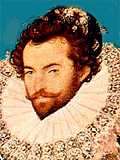RALEIGH'S FIRST EXPEDITION TO GUYANA
Close this window to return to the main menu
One of the adventurers and explorers who believed in the existence of the golden city in Guyana was the Englishman Sir Walter Raleigh, a businessman and explorer with military experience, who was also a favourite of Queen Elizabeth I. Queen Elizabeth herself was a bitter enemy of Spain with whom England was at war during the last quarter of the sixteenth century.
In 1594, Raleigh sent an expedition led by Captain Jacob Whiddon to the Guyana
region to obtain information about Manoa. He returned to England with additional
details of the myth. One year later, Raleigh himself decided to sail to Guyana
saying that, besides looking for gold, he was going there to attack the Spaniards
who had by this time established settlements on the Orinoco River. 
While one of his main aims was to search for the golden city, Raleigh also planned to set up a colony in Guyana to be used as a base from where, with the help of Amerindian allies, the Spanish would be expelled from Peru and the treasures of that region sent to England.
Raleigh first stopped at Trinidad where he attacked the newly established Spanish colony and burnt the capital, St. Joseph. With the Spanish Governor Antonio de Berrio as his prisoner, he then set off for the Orinoco to search for Manoa. Berrio, who himself had attempted to find the golden city, tried to discourage Raleigh explaining that he had lost hundreds of men, horses and cattle on his previous trips.
Raleigh and his captains, Lawrence Keymis and George Gifford, and 40 men set out in small boats in their expedition up the Orinoco. (Ocean-going vessels could not pass through the Orinoco delta). For many weeks they suffered severe privations, including the deaths by disease of some of the men, but Raleigh urged the team to press on. Eventually, they arrived at an Amerindian village where they were entertained and given gifts. The chief told them that a large gold mine was located about four days' journey farther upriver, but after searching for it, the expedition did not find it.
Raleigh's men attacked a few small Spanish settlements on the Orinoco River, and explored a few of that river's tributaries. They also questioned the Amerindians they met, but no one could provide them with information about Manoa.
He left two young members of his crew with friendly Amerindians in the right bank of the Orinoco for the purpose of learning the language of the natives. He also ordered them to learn the geography of the country and to identify suitable sites on which to establish English colonies. It certainly was Raleigh's intention of returning later.
After releasing Berrio, Raleigh returned to England with the feeling that the golden city could still be found. He encouraged his countrymen to establish a colony in the Guyana region, and to win support from the English queen and from investors, he advertised the country by describing his trip up the Orinoco in his book, The Discoverie of the Large Rich and Bewtiful Empyre of Guyana.
He described Guyana as rich and beautiful, with glorious rivers and possessing several varieties of birds and plants and delicious fruits. He stated: "Whatever prince shall possess it, that prince shall be lord of more gold, and of more cities and people than either the King of Spain or the great Turk." But he also wrote that in the interior was a tribe of Amerindians whose heads were below their shoulders!
Raleigh's book, which became very popular on the European continent, encouraged explorers to pay attention to Guyana, and by the year 1600, English, French and Dutch ships were already trading in the main rivers of the northern South American coast.